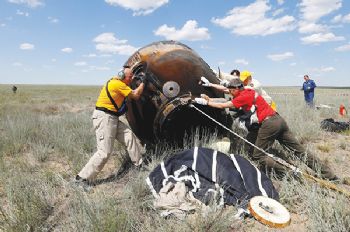
British astronaut Tim Peake returned to Earth over a week ago after completing a six-month mission to the International Space Station; and while there has been a massive amount of coverage in all forms of the media, the above picture certainly emphasises what a ‘hairy’ return ride Mr Peake and his two fellow astronauts must have had in the Soyuz capsule, which is just 7ft in diameter and 7ft tall.
Speaking about his venture before leaving the ISS, he said: “This is about the UK becoming involved in human spaceflight, hopefully for the foreseeable future. Space is going to play an increasingly important part in our lives, and if the UK is not in the forefront of that we are missing out.”
During his long stint in space, Mr Peake ran a marathon strapped to a treadmill and held a science lesson for 300,000 schoolchildren.
He had also taken with him two tiny Raspberry Pi educational computers set up to measure the space station’s environment, follow its journey through space, and pick up the Earth’s magnetic field, as well as give schoolchildren the chance to have their computer code run in space.
In fact, during his time in space, Mr Peake worked closely with schoolchildren, including inviting them to help him with a project to plant rocket seeds that he took into orbit with him, and compare their growth with rocket plants
that remained on Earth. He outlined details of the project in a message from the space station, explaining that the study will help find ways to grow food in space, which will be essential if humans travel to distant planets.
“This experiment will aim to see if microgravity can affect the growth mechanisms in seeds, which will be distributed to up to 10,000 schools.”
The experiment, called Rocket Science, could help researchers to develop hardier varieties of crops to be grown in space.